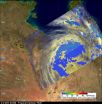(Press-News.org) (February 3, 2011) Those familiar with Chesapeake Bay know that its once-vast oyster population stands at a tiny fraction of its historical abundance. A new study by an international team including professor Mark Luckenbach of the Virginia Institute of Marine Science shows that the decline of oyster reefs is not just a local problem.
The team's global comparison of oyster reefs past and present shows that oyster reefs are at less than 10% of their prior abundance in 70% of the 144 bays studied, ranging from China to England to Australia to Brazil. Overall, they estimate that 85% of Earth's oyster reefs have been lost, typically due to overharvesting, habitat degradation, and disease.
The researchers note that the scope of oyster loss exceeds that for any other shallow-water marine habitats that have been similarly studied. "The most striking thing about our analysis," says Luckenbach, "is that it shows that oyster reefs are the most threatened of all shallow-water, structured habitats—more so than coral reefs, mangroves, or wetlands."
Luckenbach and his co-authors—who hail from California, China, Florida, Italy, New Jersey, Rhode Island, Tasmania, Uruguay, and Washington, D.C.—hope the results of the their study will help overcome what they see as one of the most pervasive obstacles to successful management of oyster reefs: "the perception among managers and stakeholders that no major problems exist."
Solutions
In addition to quantifying oyster-reef loss, the study also shows that recovery is possible, and suggests several management approaches that can aid restoration of oyster populations and the economic and ecological services they provide. Oysters filter water; offer food and habitat to fish, crabs, and birds; stabilize the shoreline; and have traditionally supported commercial fisheries.
The authors note that many of the countries in which oyster reefs remain most abundant have comparatively strong marine management policies. They suggest this link offers "a real, albeit unrealized, opportunity for reef recovery and conservation."
They further note that the few oyster reefs that have been protected, such as the "sanctuary reefs" in Chesapeake Bay, are showing signs of success. "These examples," write the authors, "indicate that protected areas are useful tools for oyster reef conservation and should be expanded."
Their other suggestions for improved oyster management include:
The prohibition of harvests where oyster populations constitute less than 10% of their prior abundances, unless it can be shown that dredging and other harvest methods do not substantially limit reef recovery.
New thinking and approaches to ensure that oyster reefs are managed not only for fisheries production but also as fundamental ecological components of bays and coasts that provide invaluable ecosystem services.
Steps to ensure that harvests, particularly those carried out by dredging, do not damage the remaining reefs.
Regular monitoring of reef conditions.
The researchers say their results also provide a useful yardstick for identifying reasonable goals for restoration and recovery, thus enhancing the chances for successful conservation and management.
They suggest, for instance, that restoration and recovery goals should require raising reef abundance and health to at least 10% of historical levels. That would equal a shift from "poor" to "fair" in the researcher's ranking scheme, which categorized the health of oyster reefs as "good" (less than 50% lost), "fair" (50% to 89% lost), "poor" (90% to 99% lost), and "functionally extinct" (more than 99% lost). They calculated the "percentage lost" by comparing current and historical oyster populations, with the historic records gathered anywhere from 20 to 130 years ago.
The researchers placed Chesapeake Bay in the "poor" category, with harvests continuing at approximately 1% of their peak levels (an annual harvest of 25,000 metric tons in the Virginian "ecoregion" today compared to harvests of 800,000 metric tons per year around 1890.)
They also call for more widespread mapping of reefs, noting that in many places the distribution of oyster habitat was better documented 100 years ago than it is today. They say the availability and relatively low cost of side-scan sonar, LIDAR, and other modern mapping techniques would facilitate this effort.
Funding & Return on Investment
The research team notes that current funding for oyster restoration is directed mainly toward enhancing oyster fisheries (and regaining fishery production following hurricanes), with the "return on investment" measured mostly by near-term harvest values.
A better approach, they say, would be to measure the long-term value of the reef's ecosystem services, which can easily exceed the value of the harvested oysters. "The desired investment outcomes," they write, "should include rebuilding the natural capital of reefs for long-term sustainable harvests and greater resilience to storms."
"We have to recognize oysters for the reef habitat they provide," says Luckenbach. "We need to work with regulators and resource managers to ensure that oyster conservation and restoration efforts are designed not just to sustain a fishery, but to provide a vibrant reef and the ecosystems services if offers."
INFORMATION:
The team's study, Oyster Reefs at Risk and Recommendations for Conservation, Restoration, and Management, appears in the February 2011 issue of BioScience.
Team members are Michael Beck (University of California, Santa Cruz), Robert Brumbaugh (The Nature Conservancy), Laura Airoldi (Università di Bologna), Alvar Carranza and Omar Defeo (Montevideo, Uruguay), Loren Coen (Sanibel-Captiva Conservation Foundation Marine Laboratory) Christine Crawford and Graham Edgar (University of Tasmania), Boze Hancock (University of Rhode Island), Matthew Kay and Hunter Lenihan (University of California, Santa Barbara), Caitlyn Toropova (International Union for the Conservation of Nature), Guofan Zhang (Chinese Academy of Sciences), and Ximing Guo (Rutgers University).
WEST LAFAYETTE, Ind. -- Surgeons of the future might use a system that recognizes hand gestures as commands to control a robotic scrub nurse or tell a computer to display medical images of the patient during an operation.
Both the hand-gesture recognition and robotic nurse innovations might help to reduce the length of surgeries and the potential for infection, said Juan Pablo Wachs, an assistant professor of industrial engineering at Purdue University.
The "vision-based hand gesture recognition" technology could have other applications, including the coordination of ...
WASHINGTON, Feb. 3, 2011 — Not even the most avid fans could notice, but those spectacular aerial images of a brightly-lit Cowboys Stadium during Sunday's Super Bowl XLV symbolize one of the hottest new pieces of scientific intelligence about air pollution:
Researchers have discovered — in a classic case of scientific serendipity — that the bright light from sports stadiums and urban street lights may boost daytime levels of ozone, a key air pollutant in many heavily populated areas. That's among the topics included in a broader article about the chemistry of air pollution ...
CORVALLIS, Ore. – Scientists are having a difficult time gauging the recovery of marine species from the Deepwater Horizon oil spill in the Gulf of Mexico because they lack sufficient data about historical population size and the distribution, growth rates and reproduction rates of many species.
In a forum paper published this week in the journal Science, they call for a new research agenda that prioritizes systematic acquisition of baseline data for marine species.
"It is impossible to diagnose whether a species is recovering or floundering if you don't have good data ...
GAINESVILLE, Fla. — Twenty years after biologists attempted to determine the ecological damages to marine life from the Exxon Valdez oil spill, scientists dealing with the BP disaster find themselves with the same problem: the lack of critical data to determine the ecological consequences of human-induced environmental disasters, a University of Florida researcher said.
Writing in the Feb. 4 issue of the journal Science, Karen A. Bjorndal, a University of Florida biology professor and director of the Archie Carr Center for Sea Turtle Research, and other biologists said ...
Bar Harbor, Maine — Researchers at Dana-Farber Cancer Institute in Cambridge, Mass., in collaboration with Jackson Laboratory scientists, have identified a regulatory defect that drives lupus.
Correcting the defect "may represent an effective therapeutic approach to systemic lupus erythematosus-like autoimmune disease," the researchers state in their research paper, published in the Proceedings of the National Academy of Sciences. The research team was led by Harvey Cantor, M.D., chair of the department of cancer immunology and AIDS at Dana-Farber, in collaboration with ...
Every day is a bad-air day on Saturn's largest moon, Titan. Blanketed by haze far worse than any smog belched out in Los Angeles, Beijing or even Sherlock Holmes's London, the moon looks like a dirty orange ball. Described once as crude oil without the sulfur, the haze is made of tiny droplets of hydrocarbons with other, more noxious chemicals mixed in. Gunk.
Icky as it may sound, Titan is really the rarest of gems: the only moon in our solar system with an atmosphere worthy of a planet. This atmosphere comes complete with lightning, drizzle and occasionally a big, summer-downpour ...
Tropical Cyclone Yasi has continued moving through inland Queensland, Australia and has weakened to a tropical depression today. NASA and JAXA's TRMM satellite passed over Yasi as it continued to drop moderate to heavy rainfall.
On February 3 at 0300 UTC (Feb. 2 at 10 p.m. EST/1 p.m. Australia local time) Tropical cyclone Yasi continued over land as a tropical storm. Yasi's maximum sustained winds were near 60 knots (69 mph/111 kmh). It was moving west-southwest near 20 knots/23 mph/37 kmh). It was located about 200 miles (321 km) southwest of Cairns, Australia near ...
PORTLAND, Ore. -- The pediatric cardiac team at Oregon Health & Science University Doernbecher Children's Hospital is the first in the region and one of a handful in the nation to implant a pulmonary heart valve without open-heart surgery.
To date, four patients have received the landmark valve in the OHSU Pediatric and Adult Congenital Cardiac Catheterization Lab. All reported immediate improvement in their energy level and stamina.
The device, called the Medtronic Melody® Transcatheter Pulmonary Valve, recently was approved by the Food and Drug Administration. The ...
ITHACA, N.Y. – Growing up poor increases a person's likelihood of health problems as an adult, but a new study led by a Cornell University environmental psychologist shows that being raised in a tight-knit community can help offset this disadvantage of poverty.
The study, "Loosening the Link Between Childhood Poverty and Adolescent Smoking and Obesity : The Protective Effects of Social Capital" published in the January 2011 edition of the peer-reviewed journal Psychological Science, found that poor adolescents who live in communities with more social cohesiveness are ...
Being successful in school requires a combination of social, emotional, and academic competencies. A new analysis of more than 200 school-based social and emotional learning programs has found that such programs improve students' attitudes and behaviors, and in some cases, even boost academic performance.
The study appears in the January/February issue of the journal, Child Development. It was conducted by researchers at Loyola University Chicago and the University of Illinois at Chicago.
In the first large-scale meta-analysis of school programs that enhance students' ...


